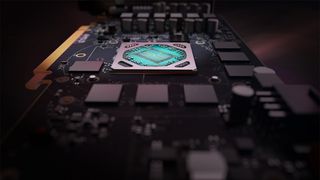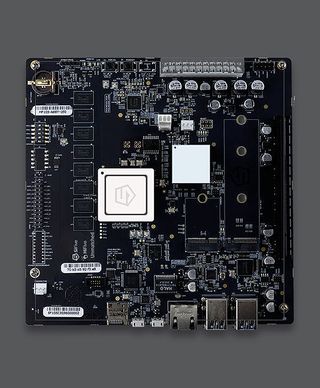World's First Desktop PC RISC-V Board Meets AMD Radeon RX 6700 XT
Gaming on RISC-V?

When SiFive introduced its HiFive Unmatchd RISC-V desktop motherboard for developers last year, it was clear from the start that sooner or later an enthusiast would attempt to try using its U7 SoC for something it is not meant for: general PC usage with high-performance graphics and video decoding. That time has come as an enthusiast has managed to make AMD's Radeon RX 6700 XT work with a RISC-V SoC under Linux.
Computer scientist René Rebe decided to prove that the SiFive HiFive Unmatched not only can run Linux, but can also use a high-performance graphics processor, reports Hackster.io. To do so, he spent 10 hours patching the Linux kernel to add support for AMD's Radeon RX 6700 XT graphics card as well as the Mesa Gallium 21.1.5 driver.
Rebe not only managed to make AMD's Radeon RX 6700 XT display Linux's GUI, but he even made it render 3D graphics in a hardware-accelerated mode and decode video. He did not try to launch games (there are certain limitations with video decoding) but as this is the world's first attempt to make a high-performance GPU work with RISC-V, the endeavor can be considered a success.

SiFive's HiFive Unmatched board with the Freedom U740 SoC has all the PC I/O interfaces that PC users are used to, including PCIe 3.0 x8/16, M.2 slots, and USB ports. To that end, it is possible to install almost any piece of modern hardware into a PC powered by the HiFive Unmatched board. After all, the board is designed for developers working on client PC and server software for upcoming RISC-V SoCs. There is a limitation though: Linux does not support RISC-V properly since most RISC-V-based chips are microcontrollers that cannot run high-level operating systems. While there are some RISC-V SoCs that can run them (e.g., the Freedom U740), they are not particularly fast.
There are more details about the SiFive Unmatched RISC-V motherboard with AMD's Radeon RX 6700 XT experiment at Bits inside by René Rebe YouTube channel.
Stay on the Cutting Edge
Join the experts who read Tom's Hardware for the inside track on enthusiast PC tech news — and have for over 25 years. We'll send breaking news and in-depth reviews of CPUs, GPUs, AI, maker hardware and more straight to your inbox.

Anton Shilov is a Freelance News Writer at Tom’s Hardware US. Over the past couple of decades, he has covered everything from CPUs and GPUs to supercomputers and from modern process technologies and latest fab tools to high-tech industry trends.
-
hotaru.hino ReplyThere is a limitation though: Linux does not support RISC-V properly since most RISC-V-based chips are microcontrollers that cannot run high-level operating systems.
I don't think it's that Linux does not support RISC-V properly. It just doesn't support this system yet.
It's a similar reason why you can't use a bog standard x64 version of Linux on a PS4. The PS4 isn't a PC. -
phatboe Reply
There is 2 things that I want to say here.Admin said:RISC-V can now work with AMD's RDNA2 GPUs.
World's First Desktop PC RISC-V Board Meets AMD Radeon RX 6700 XT : Read more
1) This is the power of releasing your drivers to the open source community. Often times someone from the community will do your work for you.
2) Last year while specing out component for a low power NAS build I was curious to see if there existed a RISC-V motherboard capable of connecting multiple hard drives and if there exists a host OS that uses ZFS that could run on RISC-V. Since then I have acquired a nas box but I think RISC-V is something that NAS makers should consider targeting. -
ezst036 Replyphatboe said:1) This is the power of releasing your drivers to the open source community. Often times someone from the community will do your work for you.
This. -
escksu Replyphatboe said:There is 2 things that I want to say here.
1) This is the power of releasing your drivers to the open source community. Often times someone from the community will do your work for you.
2) Last year while specing out component for a low power NAS build I was curious to see if there existed a RISC-V motherboard capable of connecting multiple hard drives and if there exists a host OS that uses ZFS that could run on RISC-V. Since then I have acquired a nas box but I think RISC-V is something that NAS makers should consider targeting.
I would say pros and cons.
Pros: Someone from community does the work (usually FOC).
Cons: No way for individual or small group effort to meet the capabilities of the company driver team. -
JayNor A recent article on anandtech says Intel will build a SiFive chip in 2022 on their 7nm EUV process. The article refers to the P550 cores as "linux capable".Reply
See "intel-to-create-riscv-development-platform-with-sifive-p550-cores-on-7nm-in-2022" -
Anon555 ReplyAdmin said:World's First Desktop PC RISC-V Board Meets AMD Radeon RX 6700 XT : Read more
I wouldn't call this a "desktop PC" since that implies high performance. This is a dev board with 1.2GHz in-order cores. It is slower than an old Raspberry Pi 3 which uses Cortex-A53. You might be able to run Doom on it but neither board has anywhere near enough performance to run modern games. -
hotaru.hino Reply
To add to this, this is why I'm kinda "eeeh" about community supported software. It's great when there's an actual community supporting it. It sucks when there's little to nobody supporting it. And 99.99% of all FOSS software likely lies in the latter.escksu said:Cons: No way for individual or small group effort to meet the capabilities of the company driver team.
And part of my complaint as well is if AMD is relying too much on the FOSS community to develop software for it. As someone who's worked multiple times integrating hardware into a system and whatnot, I get irate if the hardware company in question has piss poor support because I have to waste time trying to figure out how to make the damn thing work.
Most Popular


